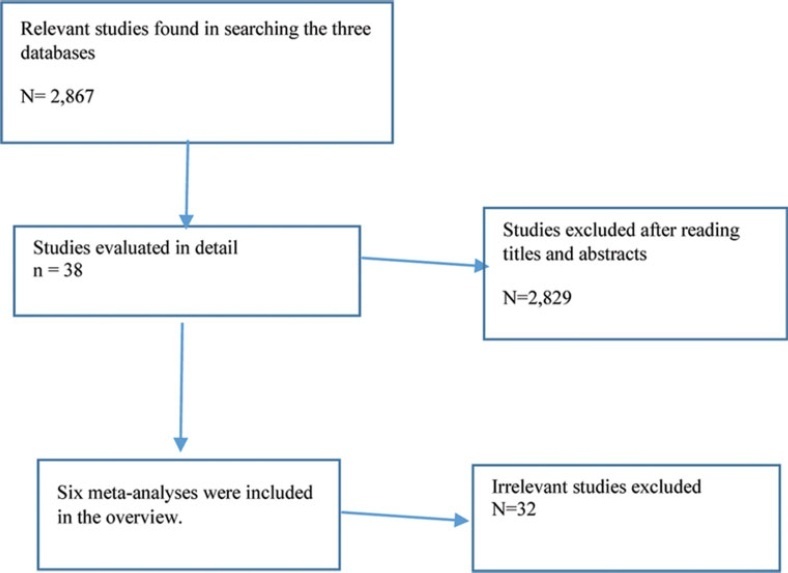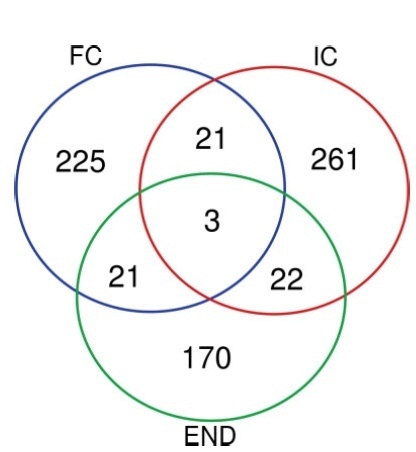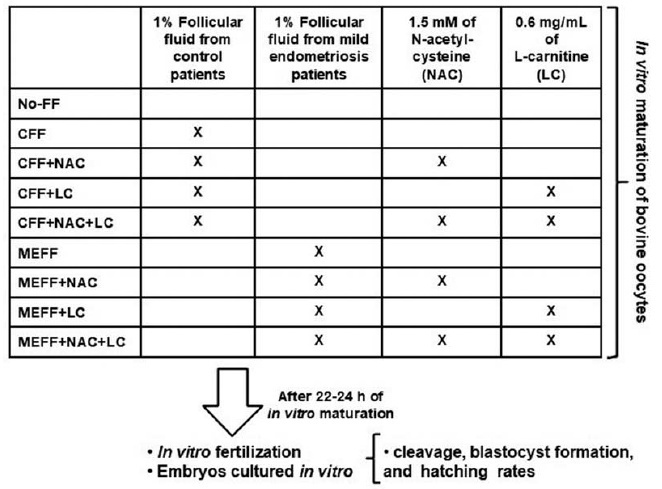-
Review Article
Cognitive Behavioral Therapy in Endometriosis, Psychological Based Intervention: A Systematic Review
Revista Brasileira de Ginecologia e Obstetrícia. 2022;44(3):295-303
06-27-2022
Summary
Review ArticleCognitive Behavioral Therapy in Endometriosis, Psychological Based Intervention: A Systematic Review
Revista Brasileira de Ginecologia e Obstetrícia. 2022;44(3):295-303
06-27-2022Views231Abstract
Introduction
Endometriosis is an inflammatory disease that affects women of reproductive age, causing pain and the possibility of infertility. Endometriosis was associated to low life quality and research shows the impact of endometriosis in several areas of life, justifying how these patients are more likely to develop depression, anxiety, and stress.
Objective
The aim of the present systematic review was to explore the field of psychology in endometriosis, identifying studies that used the cognitive behavioral therapy technique as a treatment for endometriosis and chronic pelvic pain.
Methods
The keywords used were Endometriosis and Behavioral Therapy; Behavioral Disciplines and Activities; Cognitive Behavioral Therapy; Mental Health; Psychological Techniques; Psychology; Psychotherapy; Mental Health Services; and the search was performed in the following databases: PubMed/Medline, Scielo, Lilacs, and Capes. The study followed the PRISMA guidelines and all studies whose intervention strategy used was related to cognitive-behavioral therapy were considered.
Results
Of the 129 articles found, only 5 were selected, and it was possible to identify that the psychological intervention whose approach brought cognitive-behavioral therapy techniques promoted a decrease in the sensation of pain, improvements in the scores of depression and stress, and significant changes in aspects of quality of life such as vitality, physical and social functioning, emotional well-being, control, and autonomy.
Conclusion
Cognitive-behavioral therapy can be very promising to take care of the emotional side of those who have endometriosis However, the present systematic review highlights the need to develop more structured studies with consistent, clear and replicablemethods to reach a psychological intervention protocol for patients who live with this gynecological-physical-emotional condition.
Key-words Chronic pelvic paincognitive behavioral therapyEndometriosispsychological interventionQuality of lifesystematic reviewsSee more -
Review
Effect of Surgical Treatment for Deep Infiltrating Endometriosis on Pelvic Floor Disorders: A Systematic Review with Meta-analysis
Revista Brasileira de Ginecologia e Obstetrícia. 2022;44(5):503-510
02-17-2022
Summary
ReviewEffect of Surgical Treatment for Deep Infiltrating Endometriosis on Pelvic Floor Disorders: A Systematic Review with Meta-analysis
Revista Brasileira de Ginecologia e Obstetrícia. 2022;44(5):503-510
02-17-2022Views163See moreAbstract
Objectives
To evaluate the impact of surgical treatment of deep infiltrative endometriosis (DIE) on pelvic floor dysfunction (urinary incontinence [UI], pelvic organ prolapse [POP], fecal incontinence [FI)] or constipation, and sexual function [dyspareunia]).
Data Source
The present systematic review was performed in the PubMed database. For the selection of studies, articles should be published by January 5, 2021, without language restriction.
Study Selection
Six randomized controlled studies that evaluated surgical treatment for DIE and the comparison of different surgical techniques were included.
Data Collection
The studies were selected independently by title and abstract by two authors. Disagreements were resolved by a third author. All included studies were also evaluated according to the Cochrane risk of bias tool and the quality of the evidence was analyzed using the GRADE criteria. Subgroup analysis by different treatments and follow-up periods was also performed.
Results
Six studies were included in the quantitative analysis. The risk of bias between studies showed an uncertain risk of bias for most studies, with concealment of allocation being the least reported category. The quality of the evidence was considered low. High heterogeneity was found between the studies. No study has evaluated UI or POP comparatively before and after surgery.
Conclusion
Dyspareunia and FI have improved after the surgical procedure, but it was not possible to demonstratewhich surgical technique was related to these outcomes as there was surgical heterogeneity. This diversity was found across data, with the recommendation of future prospective studies addressing pelvic floor disorders withDIE.
-
Original Article
Overview of the Effect of Complementary Medicine on Treating or Mitigating the Risk of Endometriosis
Revista Brasileira de Ginecologia e Obstetrícia. 2021;43(12):919-925
01-24-2021
Summary
Original ArticleOverview of the Effect of Complementary Medicine on Treating or Mitigating the Risk of Endometriosis
Revista Brasileira de Ginecologia e Obstetrícia. 2021;43(12):919-925
01-24-2021Views109See moreAbstract
Objective
Endometriosis is a hormone-dependent chronic inflammatory disease with symptoms such as pelvic pain, which affect the physical, emotional, and social health of women in reproductive age. The current overview article aims to explore the effect of complementary medicine on the treatment or in mitigating the risk of endometriosis.
Methods
This is an overview article done in Iran. Two separate researchers systematically searched 3 databases (Medline, Scopus, and Cochrane Central Register Trials) until September 2020. The methodological quality of each study was assessed using the assessment of multiple systematic reviews (AMSTAR) tool.
Results
The results of two reviews suggested that physical activity, tobacco smoking, diet, coffee and caffeine intake had no effect on mitigating the risk of endometriosis or improving its treatment, but acupuncture successfully reduced pain and related marker (serum CA-125) levels.
Conclusion
As endometriosis is an annoying disease with many complications and is hard to diagnose and treat, related studies in complementary medicine can help patients with endometriosis. Based on the relevant literature review, among the complementary medicine available for the treatment or to mitigate the risk of endometriosis, only acupuncture seems to alleviate the pain of endometriosis.

-
Original Article
Psychological Problems Experienced by Patients with Bowel Endometriosis Awaiting Surgery
Revista Brasileira de Ginecologia e Obstetrícia. 2021;43(9):676-681
11-29-2021
Summary
Original ArticlePsychological Problems Experienced by Patients with Bowel Endometriosis Awaiting Surgery
Revista Brasileira de Ginecologia e Obstetrícia. 2021;43(9):676-681
11-29-2021Views167Abstract
Objective
To assess the most common psychological disturbances in women with deep endometriosis and bowel involvement who are waiting surgical treatment and to evaluate what forms of coping are used to solve the problem.
Methods
This was a cross-sectional observational study of 40 women diagnosed with deep endometriosis and intestinal symptoms. They completed two questionnaires: one for anxiety and depression (Hospital Anxiety and Depression Scale [ HADS]) and the Scale of Mode of Confronting Problems (EMEP, in the Portuguese acronym).
Results
We found that 77.1% of the patients had anxiety and depression, with anxiety being the most prevalent (87.5% of the patients); 90% of the patients used problem focused and religious introspection as their main modes of confronting problems.
Conclusion
In the use of the HADS questionary, two psychological aspects were the most present in women with deep endometriosis awaiting surgical treatment: anxiety and depression. The most used forms of coping to solve the problem were problem coping and religious practices.
Key-words anxiety disordersCross-sectional studiesdepressive disordersEndometriosispsychological adaptationSee more -
Original Article
Screening of Variants in the Transcript Profile of Eutopic Endometrium from Infertile Women with Endometriosis during the Implantation Window
Revista Brasileira de Ginecologia e Obstetrícia. 2021;43(6):457-466
07-27-2021
Summary
Original ArticleScreening of Variants in the Transcript Profile of Eutopic Endometrium from Infertile Women with Endometriosis during the Implantation Window
Revista Brasileira de Ginecologia e Obstetrícia. 2021;43(6):457-466
07-27-2021Views155See moreAbstract
Objective
Abnormalities in the eutopic endometrium of women with endometriosis may be related to disease-associated infertility. Although previous RNA-sequencing analysis did not show differential expression in endometrial transcripts of endometriosis patients, other molecular alterations could impact protein synthesis and endometrial receptivity. Our aim was to screen for functional mutations in the transcripts of eutopic endometria of infertile women with endometriosis and controls during the implantation window.
Methods
Data from RNA-Sequencing of endometrial biopsies collected during the implantation window from 17 patients (6 infertile women with endometriosis, 6 infertile controls, 5 fertile controls) were analyzed for variant discovery and identification of functional mutations. A targeted study of the alterations found was performed to understand the data into disease’s context.
Results
None of the variants identified was common to other samples within the same group, and no mutation was repeated among patients with endometriosis, infertile and fertile controls. In the endometriosis group, nine predicted deleterious mutations were identified, but only one was previously associated to a clinical condition with no endometrial impact. When crossing the mutated genes with the descriptors endometriosis and/or endometrium, the gene CMKLR1 was associated either with inflammatory response in endometriosis or with endometrial processes for pregnancy establishment.
Conclusion
Despite no pattern of mutation having been found, we ponder the small sample size and the analysis on RNA-sequencing data. Considering the purpose of the study of screening and the importance of the CMKLR1 gene on endometrial

-
Original Article
The Graduated Embryo Score of Embryos from Infertile Women with and without Peritoneal Endometriosis
Revista Brasileira de Ginecologia e Obstetrícia. 2021;43(1):28-34
03-08-2021
Summary
Original ArticleThe Graduated Embryo Score of Embryos from Infertile Women with and without Peritoneal Endometriosis
Revista Brasileira de Ginecologia e Obstetrícia. 2021;43(1):28-34
03-08-2021Views116See moreAbstract
Objective
To determine embryo quality (mean graduated embryo score [GES]) in infertile patients with endometriosis undergoing in vitro fertilization with embryo transfer (IVF-ET) compared with infertile patients without endometriosis.
Methods
A case-control study was performed comparing 706 embryos (162 patients) divided into 2 groups: 472 embryos derived from patients without endometriosis (n= 109, infertile patients with tubal infertility) and 234 embryos from patients in the study group (n= 53, infertile patients with peritoneal endometriosis). All patients were subjected to IVF using an oestradiol-antagonist-recombinant follicle-stimulating hormone (FSH) protocol for ovarian stimulation. Themean GESwas performed to evaluate all embryos at 3 points in time: 16 to 18 hours, 25 to 27 hours, and 64 to 67 hours. Embryo evaluation was performed according to the following parameters: fragmentation, nucleolar alignment, polar body apposition, blastomere number/morphology, and symmetry. The primary outcomemeasure was the mean GES score.We also compared fertilization, implantation, and pregnancy rates.
Results
Although the number of embryos transferred was greater in patients with endometriosis than in the control group (2.38 ± 0.66 versus 2.15 ± 0.54; p= 0.001), the meanGESwas similar inbothgroups (71 ± 19.8 versus 71.9 ± 23.5; p= 0.881). Likewise, the fertilization ratewas similar in all groups, being 61% in patients with endometriosis and 59% in the control group (p= 0.511). No significant differences were observed in the implantation (21% versus 22%; [p= 0.989]) and pregnancy rates (26.4% versus 28.4%; p= 0.989).
Conclusion
Embryo quality measured by the mean GES was not influenced by peritoneal endometriosis. Likewise, the evaluated reproductive outcomes were similar between infertile patients with and without endometriosis.
-
Original Article
Follicular Fluid from Infertile Women with Mild Endometriosis Impairs In Vitro Bovine Embryo Development: Potential Role of Oxidative Stress
Revista Brasileira de Ginecologia e Obstetrícia. 2021;43(2):119-125
01-28-2021
Summary
Original ArticleFollicular Fluid from Infertile Women with Mild Endometriosis Impairs In Vitro Bovine Embryo Development: Potential Role of Oxidative Stress
Revista Brasileira de Ginecologia e Obstetrícia. 2021;43(2):119-125
01-28-2021Views128See moreAbstract
Objective
To investigate whether follicular fluid (FF) from infertile women with mild endometriosis (ME) alters in vitro bovine embryo development, and whether the antioxidants N-acetyl-cysteine (NAC) and/or L-carnitine (LC) could prevent such damages.
Methods
Follicular fluid was obtained from infertile women (11 with ME and 11 control). Bovine oocytes were matured in vitro divided in: No-FF, with 1% of FF from control women (CFF) or ME women (MEFF); with 1.5mM NAC (CFF + NAC, MEFF + NAC), with 0.6mg/mL LC (CFF + LC, MEFF + LC), or both antioxidants (CFF + NAC + LC, MEFF + NAC + LC). After in vitro fertilization, in vitro embryo culture was performed for 9 days.
Results
A total of 883 presumptive zygotes were cultured in vitro. No differences were observed in cleavage rate (p = 0.5376) and blastocyst formation rate (p = 0.4249). However, the MEFF group (12.5%) had lower hatching rate than the No-FF (42.1%, p = 0.029) and CFF (42.9%, p = 0.036) groups. Addition of antioxidants in the group with CFF did not alter hatching rate (p ≥ 0.56), and in groups with MEFF, just NAC increased the hatching rate [(MEFF: 12.5% versus MEFF + NAC: 44.4% (p = 0.02); vs MEFF + LC: 18.8% (p = 0.79); versus MEFF + NAC + LC: 30.8% (p = 0.22)].
Conclusion
Therefore, FF from infertile women with ME added to medium of in vitro maturation of bovine oocytes impairs hatching rate, and NAC prevented these damages, suggesting involvement of oxidative stress in worst of oocyte and embryo quality of women with ME.

-
Original Article
Is there an Increased Risk for Unfavorable Obstetric Outcomes in Women with Endometriosis? An Evaluation of Evidences
Revista Brasileira de Ginecologia e Obstetrícia. 2020;42(4):200-210
05-18-2020
Summary
Original ArticleIs there an Increased Risk for Unfavorable Obstetric Outcomes in Women with Endometriosis? An Evaluation of Evidences
Revista Brasileira de Ginecologia e Obstetrícia. 2020;42(4):200-210
05-18-2020Views110Abstract
Objective
The present study is a systematic review of the literature to assess whether the presence of endometriosis determines or contributes to adverse obstetric outcomes.
Data Sources
The present work was carried out at the Hospital Israelita Albert Einstein, São Paulo, state of São Paulo, Brazil, in accordance to the PRISMA methodology for systematic reviews. A review of the literature was performed using PubMed, Web of Science and Scopus databases. The keywords used were: pregnancy outcome, pregnancy complications, obstetrical complications, obstetrics, obstetric outcomes and endometriosis. The survey was further completed by a manually executed review of cross-referenced articles, which was last performed on November 30, 2018.
Selection of studies
The survey disclosed a total of 2,468 articles, published from May 1946 to October 2017. A total of 18 studies were selected to be further classified according to their quality and relevance.
Data Collection
The Newcastle-Ottawa Quality Assessment Scale was used for classification. Five studies of greater impact and superior evidence quality and 13 studies of moderate evidence quality were selected. We analyzed the studies for the characteristics of their patients plus how endometriosis was diagnosed and their respective obstetric outcomes taking into account their statistical relevance.
Data Synthesis
Analyses of the higher impact and better quality studies have shown high incidence of preterm birth and placenta previa in patients with endometriosis.
Conclusion
Placenta previa and preterm birth are the most statistically significant outcomes related to endometriosis, as indicated by our systematic review. The present information is useful to alert obstetricians and patients about possible unfavorable obstetric outcomes.
Key-words EndometriosisObstetric complicationsobstetric outcomesPregnancy complicationspregnancy outcomesSee more


